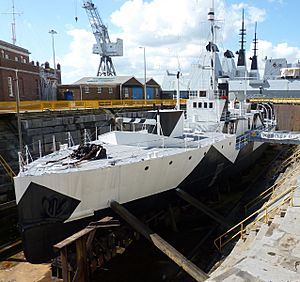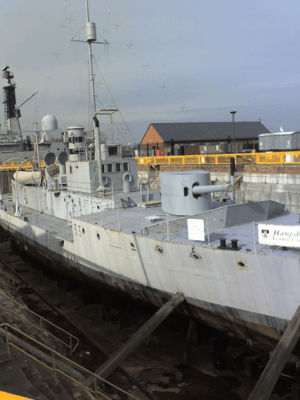HMS M33 facts for kids
class="infobox " style="float: right; clear: right; width: 315px; border-spacing: 2px; text-align: left; font-size: 90%;" |+HMS M33
| colspan="2" style="text-align: center; font-size: 90%; line-height: 1.5em;" |
|} HMS M33 is a special type of warship called an M29-class monitor. She was built for the Royal Navy in 1915. This ship saw action in the Mediterranean Sea during the First World War. She also helped in Russia during a civil war in 1919.
After her fighting days, M33 had many different jobs. She was a training ship for laying mines. She also served as a floating workshop and office. During this time, her name changed to HMS Minerva and later Hulk C23. Today, M33 is a museum ship. She is located at Portsmouth Historic Dockyard and opened to visitors in 2015. She is one of only three Royal Navy warships from the First World War that still exist. She is also the only surviving ship from the Gallipoli Campaign.
Contents
Building a Warship
M33 was built very quickly when the First World War started. She was made by Harland and Wolff in Belfast. The order for her was placed in March 1915. She was launched into the water in May and ready for duty in June. This was an amazing speed for building a ship. Many other ships like her were also being built at the same time.
Fighting in World War I
M33 had two large 6-inch (152 mm) guns. She was designed to sail in shallow water. This made her perfect for shooting at targets on land from the sea. Her first mission was to help British soldiers land at Suvla Bay. This happened during the Gallipoli Campaign in August 1915.
She stayed at Gallipoli until the soldiers left in January 1916. For the rest of the war, she served in the Mediterranean Sea. She was involved in taking control of the Greek navy's ships. This event happened at Salamis Bay on September 1, 1916.
Missions in Russia
M33during restoration in February 2007
After the First World War, M33 went to Murmansk in 1919. She was with five other monitor ships. Their job was to help the British forces already in Russia. In June, M33 moved to Archangel. Her shallow design allowed her to travel up the Dvina River. This helped her cover the retreat of British and White Russian forces.
The river level became very low at one point. The ship's guns had to be taken off and moved by carts. Two other ships, M25 and M27, were not as lucky. They got stuck and had to be sunk on purpose on September 16, 1919. M33 safely returned to Chatham in October.
A Long Life: From Warship to Museum
In 1925, M33 became a training ship for laying mines. She was renamed HMS Minerva on February 3, 1925. Over the years, she had many different jobs. She was used to store fuel for other ships. She also became a workshop for boom defence, which protects harbors. In 1939, her name changed again to Hulk C23.
In 1946, she became a floating office in Gosport. She was put up for sale in 1984. Eventually, she was given to Hampshire County Council. Today, she is part of the National Historic Fleet. This means she is a very important old ship. She is now at Portsmouth Historic Dockyard, near HMS Victory. She opened to the public as part of the National Museum of the Royal Navy on August 7, 2015. M33 is one of only three British warships that fought in the First World War that are still around. The others are HMS Caroline and HMS President.
| History | |
|---|---|
| Name |
|
| Ordered | 15 March 1915 |
| Builder | Workman Clark, Belfast for Harland and Wolff |
| Yard number | 489 |
| Launched | 22 May 1915 |
| Completed | 26 June 1915 |
| Commissioned | 24 June 1915 |
| Status | Museum ship, Portsmouth |
| General characteristics | |
| Class and type | M29-class monitor |
| Displacement | 580 tons deep load |
| Length | 177 ft 3 in (54.03 m) |
| Beam | 31 ft (9.4 m) |
| Draught | 5 ft 11 in (1.80 m) |
| Installed power | 4,000 hp (2,980 kW) |
| Propulsion |
|
| Speed | 9.6 knots (18 km/h) |
| Range | 1,440 nautical miles (2,670 km) at 8 knots (15 km/h) |
| Complement | 72 |
| Armament |
|



